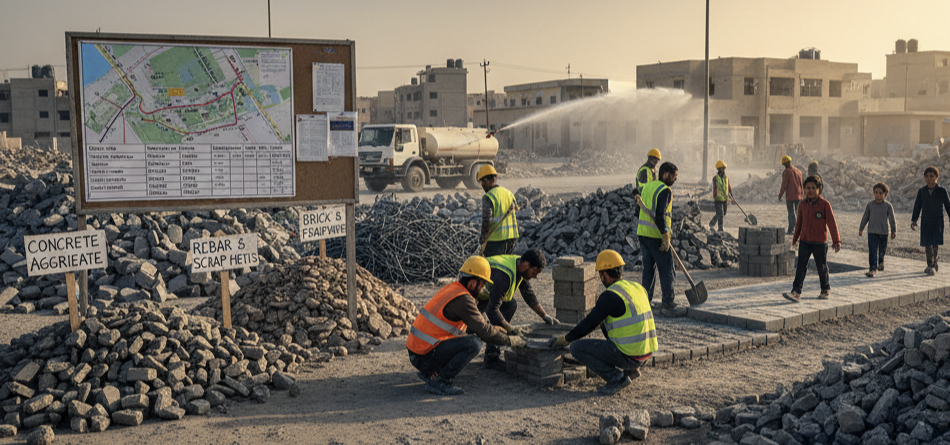If we teach the system on day one that unsorted dumping is acceptable, that weighbridges can be bypassed, that dust is the neighborhood’s problem, we will spend the next five years unlearning our own curriculum.
Following the argument in “From Ruin to Spatial Justice: Reimagining Reconstruction in Gaza (1)”, and on the day active hostilities are declared over—just as anticipated on October 5—this essay asks a simple question with far-reaching consequences: what if debris were treated not as a nuisance to be hidden, but as the first civic act of return?
When a war ends, the natural impulse is to rush toward walls and roofs—to see vertical progress and feel that normal life is within reach. In Part (1), I argued that what collapsed in Gaza was not merely concrete, but a spatial order that bound daily life to place. Today, in the first quiet after the noise, our choices about rubble will signal whether we intend to rebuild that order or simply pour it into new molds.
Debris is an uncomfortable inheritance: vast, heterogeneous, sometimes toxic, always in the way. But it is also the first material with which the future must reckon. To shovel it away is reflex; to understand it is policy. The city’s recovery begins when debris stops being anonymous. Piles must acquire names, weights, sources, and destinations—the basic grammar of accountability. Without that grammar, rubble becomes a traveling harm: dust that abrades lungs, fragments that reappear in flood channels, clandestine dumping that seeps into aquifers and memory alike.
There is ethics in choreography. The staging yards we choose are not empty space; they are decisions about who breathes dust and who sleeps easier. Truck routes are not lines on a dispatch sheet; they are promises to children who must cross streets to reach the first reopened school. Hours of movement are not logistics alone; they are a quiet pact with neighborhoods that have finally heard silence. Even water trucks used to suppress dust are statements about value—do we accept the daily abrasion of particulate matter because it is “only temporary,” or do we insist that health is part of reconstruction from hour one?
And then there is quality: a word that sounds luxurious in an emergency until one remembers that poor-quality sub-base will betray the first rains, and that non-structural blocks made from poorly sorted rubble will fail long before the loan is paid. If debris is to become the substrate of roads and the skin of courtyards, it must pass through the sieve of care. That care is not expensive heroism—it is discipline: separating the hazardous from the inert; testing, even with modest field kits; refusing the easy path of the unsorted load that “will do for now.” The difference between a circular economy and a circular harm is a handful of decisions repeated thousands of times.
There is also dignity in labor. Cash-for-work schemes are often dismissed as stopgaps. Here, handled properly, they become the first architecture of trust. When local crews—women and men, youths and experienced builders—sort and process rubble into pavers, kerbs, and non-structural blocks, the city does not merely clean itself; it apprentices its own citizens into the craft of their return. This is not romance. It is procurement with a conscience: municipal purchase commitments for locally produced elements; clear safety training and protective gear; micro-enterprise support that tethers livelihoods to visible improvements on the same streets where people will walk tomorrow.
Transparency is the companion of dignity. A simple ledger that records where each load comes from and where it goes, a public board that reports daily tonnages and destinations, even a modest map updated weekly—these instruments matter not because they impress donors, but because they invite residents into authorship. When a mother sees that the pile across from her building has a destination beyond the nearest wadi; when a market vendor learns the hour when trucks will not cut off his morning crowd; when a school principal can request dust suppression around exam time—reconstruction becomes a conversation rather than a procession of machines.
Environmental justice sits under all of this like a water table. Gaza’s ground does not forget. Dumping in lowlands will return as winter floods that carry the city’s impatience back into its courtyards. Spreading unsorted rubble along coastal dunes may seal off the very lungs the shoreline offers. The debris we wish to forget will, if mishandled, become the infrastructure of forgetting: clogged drains, broken ankles, muddy lanes that lengthen the walk to school. Conversely, debris handled with attention can birth the first public works of return: stabilized footpaths linking temporary clinics, raised crossings that keep children dry, rain gardens planted where silt once ponded. The palette is humble—sub-base, pavers, small retaining walls—but the effect is profound: the city begins to breathe where it once choked.
Some will say that such care delays what truly matters: permanent facilities, bright facades, wide roads. The truth is less flattering and more useful. Cities remember shortcuts. If we teach the system on day one that unsorted dumping is acceptable, that weighbridges can be bypassed, that dust is the neighborhood’s problem, we will spend the next five years unlearning our own curriculum. If we teach, instead, that every load has a story; that residents are informed, not merely informed upon; that quality is measured before ribbon-cuttings—we will find that the same crews who learned to separate rubble can be trusted to lay pavers well, to prepare sub-grades that do not drown, to build thresholds that keep damp from creeping up bedroom walls.
What of speed? There is no contradiction between pace and principle. Clarity accelerates. When sites are known, routes announced, standards fixed and public, contractors work rather than wait for decisions that change with every phone call. When communities know the plan, they police it because it protects their throats and wallets. When donors see daily evidence that tons removed become meters of safe path rather than phantom work, they release the next tranche without the theater of doubt. The fastest road is the one we do not have to rebuild.
The social meaning of debris is often overlooked. Those piles are, painfully, the last visible archives of homes—beds and books pulverized into a granular archive. To process them with indifference is to ask people to forget twice. To process them with ceremony—information, participation, visible care—is to say that the city will not be rebuilt against its people’s memory, but with it. A courtyard paved in the first pavers pressed from a neighborhood’s own rubble is not a gimmick; it is a declaration that return is made of continuity as much as of novelty.
Treating debris as a beginning does not solve the next knot—property, tenure, the right to stay in place. But it prepares the ground for it, literally and figuratively. When blocks are identified, when streets are passable, when temporary services are reachable without a gauntlet of dust and hazard, conversations about who belongs where can occur without the humiliation of navigating a junkyard. The ethics learned in rubble—naming, testing, informing, including—are the same ethics that will allow a participatory cadastre to function and be believed.
In the months ahead, Gaza will be full of urgent needs that shout. Debris management whispers, but it whispers at scale and in the grammar of the everyday. It is the first test of whether spatial justice is a slogan or a method. If we pass it—if we show that the city’s first acts after war are careful, intelligible, and shared—then the road to housing with dignity and infrastructure that doesn’t fail at the first storm will no longer be theoretical. It will already have begun under our feet, one measured load at a time.

